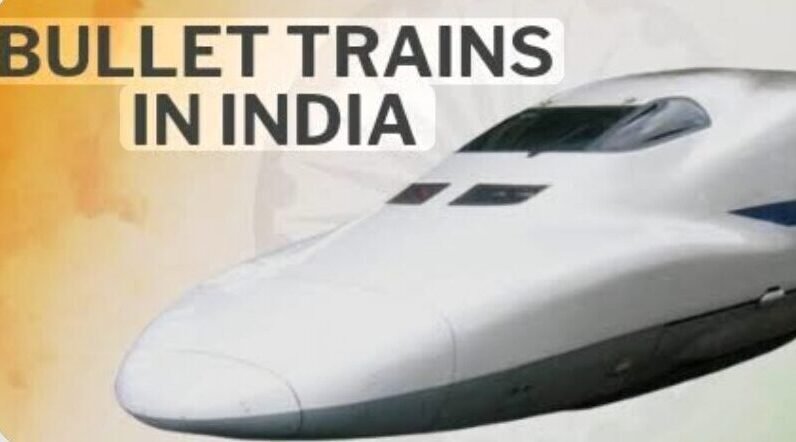Does India have bullet train technology?
India is actively working on introducing bullet train technology, marking a significant step in the modernization of its railway infrastructure. Despite the fact that India does not yet have a full-scale bullet train system, it has started major projects with Japan, a country with expertise in high-speed rail technology. Here’s an in-depth look at India’s bullet train journey.
What is Bullet Train Technology?
Bullet train technology refers to high-speed rail systems designed to operate at speeds exceeding 250 km/h, offering rapid, safe, and efficient travel over long distances. Originating in Japan with the Shinkansen in 1964, bullet trains are engineered with aerodynamic designs, lightweight materials, and advanced propulsion systems that minimize drag and maximize speed.
These trains run on specially built, dedicated tracks—typically slab-based or ballastless—to ensure stability at high velocities.
Key components include high-powered electric motors, real-time signaling systems, and automated safety controls that prevent collisions and derailments. Advanced features like tilting mechanisms, regenerative braking, and low-noise operations also enhance passenger comfort and environmental performance.
Countries like Japan, France, China, and Germany have successfully developed and deployed indigenous bullet train systems.
Bullet train technology is now being adopted by other nations, including India, as a futuristic solution for modernizing rail transport and supporting economic growth through faster, more efficient connectivity.
Mumbai-Ahmedabad High-Speed Rail (MAHSR)
- Project Type: India’s first bullet train corridor
- Route: Mumbai to Ahmedabad (508 km)
- Technology: Based on Japan’s Shinkansen E5 system
- Speed: Up to 320 km/h
- Construction: Ongoing, over 300 km of viaduct completed
- Funding: Largely financed by Japan International Cooperation Agency (JICA)
- Expected Launch: Phase-wise, starting from 2026
The Mumbai-Ahmedabad Bullet Train Project
The most prominent and ambitious bullet train project in India is the Mumbai-Ahmedabad High-Speed Rail Corridor. This project is being developed with technical and financial assistance from Japan. The train will use Shinkansen technology from Japan, which is well-known worldwide for its speed, efficiency, and safety. Once operational, this train is expected to run at a speed of up to 320 km/h, reducing the travel time between Mumbai and Ahmedabad from about 7 hours to just around 2 hours.Does India have bullet train technology?
Watch This bullet Short
India Bullet Train – Key Details
| Feature | Details |
|---|---|
| Project Name | Mumbai–Ahmedabad High-Speed Rail |
| Top Speed | 320 km/h |
| Average Speed | 250–280 km/h |
| Route Length | 508 km |
| Stations | 12 (Mumbai, Surat, Ahmedabad, etc.) |
| Travel Time | Approx. 2–2.5 hours |
| Estimated Ticket Price | ₹2,500 – ₹3,000 (Economy), ₹5,000+ (Business) |
| Technology | Japanese Shinkansen (E5 Series) |
| Expected Launch | 2026 |
| Operating Body | NHSRCL (India) with JICA (Japan) |
The total lengthy of this corridors is approximately 508 kilometres, and it will include 12 station’s. The National High-Speed Rail Corporation Limited (NHSRCL) is carrying out the project. Construction began in 2017, and after facing delays due to land acquisition and the COVID-19 pandemic, the first phase is now expected to be operational by 2026.Does India have bullet train technology?
Mumbai–Ahmedabad High-Speed Rail (MAHSR) Project
- Route: Mumbai (Maharashtra) to Ahmedabad (Gujarat)
- Total Length: 508 kilometers
- Top Speed: 320 km/h
- Technology: Japanese Shinkansen (E5 Series)
- Implementing Agency: National High-Speed Rail Corporation Limited (NHSRCL)
- Funding: Largely financed by Japan through a soft loan
- Expected Completion: Phase-wise launch by 2026
The MAHSR is India’s first bullet train project and marks the beginning of high-speed rail infrastructure in the country.
Technological Collaborations
The Japanese International Cooperation Agency (JICA) is providing a soft loan covering around 81% of the project cost. Japanese engineers are also providing expertise and training Indian professionals to ensure efficient technology transfer and skill development.
Infrastructure and Safety
One of the key aspects of the bullet train technology is dedicated high-speed rail tracks, which are completely isolated from conventional rail traffic. The bullet train system includes advanced signaling, earthquake detection systems, and automated safety protocols, making it one of the safest forms of travel.
The use of elevated tracks and underground tunnels, including a Kilometre undersea tunnel, reflects India’s ambition to match global standards in rail infrastructure.Does India have bullet train technology?
Future Bullet Train Corridors Planned in India
- Delhi – Varanasi
- Delhi – Ahmedabad
- Mumbai – Nagpur
- Chennai – Bengaluru – Mysuru
- Delhi – Amritsar via Chandigarh
- Hyderabad – Bengaluru
These corridors are in various stages of planning and feasibility study, aiming to build a nationwide high-speed rail network.
Future Expansion Plans
India intends to construct additional high-speed corridors, including Delhi–Varanasi, Mumbai–Nagpur, and Chennai–Mysuru, inspired by the project’s progress. These corridors will boost regional economies, reduce travel time, and promote sustainable, modern transport systems.
Conclusion
While India does not yet operate a bullet train, it is well on its way to becoming one of the countries equipped with high-speed rail technology. With international cooperation, robust planning, and a vision for the future, India’s bullet train projects symbolize a transformative shift in the nation’s transport landscape.
